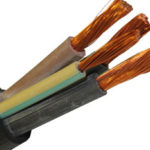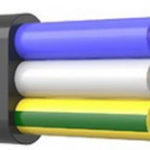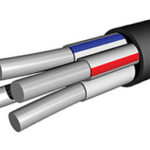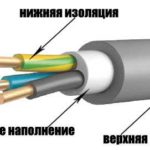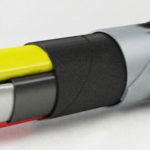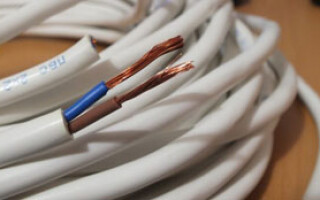The simplest and most affordable conductor used in everyday life is the PVA wire. It can be easily found in every apartment. It is used as an elastic connection of household electrical appliances with a plug or plug. Multiple bends and movements do not affect its operation and reliability, do not violate the quality of insulation, and strength characteristics ensure integrity with constant, but small stretching or compression. Among the useful properties of PVA, one can distinguish that it is soft to the touch and has a familiar aesthetic appearance.
It is also used for the installation of fixed wiring, especially in cases where a temporary connection of the consumer with a power source is required, located at a distance of several meters from each other. Such a conductor, if necessary, can be safely hung above the ground, and large spans can be left between the attachment points. And if you need to quickly throw the wiring along a complex and winding path, then it is easier to use just such a soft and elastic electrical wire.
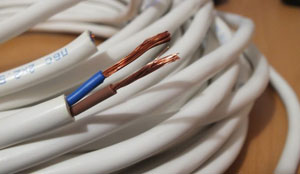
Content
Description of properties and decoding of PVA
PVS wires are used not only for connecting household appliances to a voltage of 220 V. Separate varieties can be used to transmit voltage up to 660 V. The service life of the wire can also vary from 2 to 10 years. It all depends on the operating conditions and the quality of the insulation material. The abbreviation for the name of the PVS wire means:
- "P" - conductor.
- "B" - polyvinyl chloride insulation.
- "C" - "network".
Also, this abbreviation indicates the method of packing the conductive cores into a single cylindrical PVC bag.
One of the purposes of the PVA wire is the possibility of outdoor operation. Therefore, the permissible operating temperature range for it is from -30 ° frost to + 45 ° heat. The permissible heating temperature of the PVA wire is + 80 °, after which its sheath begins to melt and collapse, which can lead to a short circuit. The PVA cable is considered a flexible conductor, but it has a bending strength of up to 50,000 in one section.
Design features
The PVS cable consists of several components:
- The number of conductors is from 2 to 5. They are made of thin copper wire woven into dense strands.
- PVC insulation. Each core is covered with it, and all the cores are in a common PVC insulating package with a round cross section.
- To designate the phase conductors, colored insulation of such colors as brown, gray, yellow, red and black is used.
- The neutral conductor shell is always blue.
- In the presence of a grounding element, its coating has either green or yellow-green color.
The cross-sectional dimensions of the PVA core range from 0.4 cm² to 0.5 mm². The color of the outer sheath of the PVA wire is most often white. But there are two-color options - with longitudinal stripes of contrasting shades. The outer insulation is soft, cuts well with a knife and can be easily removed during installation operations. Depending on the cross-section and the number of cores, the weight of 1 km of the product can be from 50 to 250 kg.
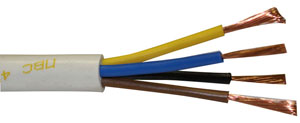
Marking
For existing PVC grades, the decoding of designations has the following standards (GOST 7399-97):
- Tinned copper as phase conductors - PVSl;
- Antiseptic additives in the composition of the insulation material - PVSt;
- Flat section of the outer insulating layer - "SHV";
- Reinforced outer protective shell - "B";
- The insulation material has an increased resistance to combustion - "PS".
In addition to the letter code, there are numbers in the marking of the PVC cable, the decoding of which is carried out in the following order:
- The number of conductors indicates the first digit.
- After the “x” icon, the cross-sectional area of \u200b\u200b1 core in millimeters follows:
| Two-core | Three-core | Four-core | Five-core |
| 2x2.5 | 3x2.5 | 4x2.5 | 5x2.5 |
| 2x1.5 | 3x1.5 | 4x1.5 | 5x1.5 |
| 2x1 | 3x1 | 4x1 | 5x1 |
| 2x0.75 | 3x0.75 | 4x0.75 | 5,0,75 |
The same figures indicate the weight of 1 km of the product:
| 0.75 mm² | 0.1 mm² | 1.5 mm² | 2.5 mm² | |
| Two-core | 55.8 kg | 66.1 kg | 79.8 kg | 102 kg |
| Three-core | 63.7 kg | 76.5 kg | 96.5 kg | 118.4 kg |
| Four-core | 85.15 kg | 107 kg | 134.5 kg | 170.6 kg |
| Five-core | 133 kg | 166.7 kg | 203.8 kg | 257.6 kg |
Characteristics
PVS wires have the following technical characteristics:
- Depending on the section of the phase elements, the product can withstand current up to 2 kW;
- When stretched, the gap occurs after the length increases by one and a half times;
- The optimum operating temperature ranges from plus 40˚C to minus 25˚C;
- PVA frost-resistant grades are marked with a special symbol "Y". It indicates the lower temperature threshold up to -40 ˚C;
- The warranty period is usually 2 years;
- With a single laying, the shell of the product does not support combustion. In the event of a fire with prolonged contact with an open flame, it has the property of self-extinguishing;
- PVA-T has a coating that has a number of special properties that increase the service life in hot and humid climates;
- Allowed to use at high humidity (up to 98%);
- The safe bending radius is at least 4 cm;
- The resource of uninterrupted operation when used as a temporary wiring or carrying element is 5000 hours. When used as fixed and permanent wiring - 12,000 hours.
PVA cable from different manufacturers may have different technical characteristics, even if the markings match. Differences may relate to such parameters as:
- Thickness of the insulating layer;
- Cross section of conductors;
- The number of copper wires in the core strand.
An exact description of the properties of a particular PVA can be found in the supplier's documentation.
Scope of application and features of operation
PVA wires have the following applications:
- At home;
- in production;
- As a general wiring in buildings and structures.
Examples of domestic use are the following devices:
- Carriers;
- Connections of household electrical appliances to the network;
- As wiring when installing sockets, switches, stationary household lighting fixtures.
Advantages:
- Favorable resistance parameters.
- Resistance to mechanical deformations.
- Minimum expansion when heated.
- Preservation of operating parameters during sudden power surges in the network.
The advantages of PVA flexible wire allow it to be used in the installation of urban lighting, wiring in apartment buildings and for connecting industrial electrical installations.
Similar articles:

